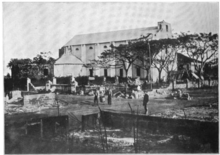Battle of Caloocan
| Battle of Caloocan | |||||||
|---|---|---|---|---|---|---|---|
| Part of Philippine-American War | |||||||
 Maj. Gen. Arthur MacArthur observing the battle | |||||||
| |||||||
| Belligerents | |||||||
|
|
| ||||||
| Commanders and leaders | |||||||
|
|
| ||||||
| Strength | |||||||
|
127 officers 3,185 soldiers[1] 2 Warships | Unknown | ||||||
This Battle of Caloocan was a battle fought in the early stages of the Philippine-American War.
Background
After the Battle of Manila on 4–5 February 1899, Filipino forces which had been pushed out of a strong position on the Santa Mesa ridge north of the City regrouped at Caloocan about 12 miles north of Manila.[2]:56 General Arthur MacArthur wanted to attack immediately, but was urged by General Elwell Otis to delay a few days to allow time both for reinforcements to be shifted into position and for the Filipino forces to concentrate into the Caloocan pocket.[2]:56–57
Battle

At 4 pm on 10 February, after three hours of preparatory bombardment by the Utah battery of the 6th Artillery and naval gunfire from the USS Charleston and the USS Monadnock, MacArthur's 1st Brigade under General Harrison G. Otis began the ground attack and overwhelmed the defending Filipino forces.[2]:57 After a short, vicious fight at the town church,[2]:57 Filipino forces retreated towards Malolos, the capital of the First Philippine Republic.
Result
The capture of Caloocan left American forces in control of the southern terminus of the Manila to Dagupan railway, along with five engines, fifty passenger coaches, and a hundred freight cars.[2]:57 After consolidating control of Caloocan, the obvious next objective for American forces would be the Filipino's capital at Malolos. However, General Otis delayed for almost a month in hopes that Filipino forces would be deployed in its defense.[2]:92
Colonel W. S. Metcalfe was later accused by some of his men of having been responsible for the shooting of unarmed prisoners at this battle.[4][5] Brigadier General Frederick Funston was accused of interfering with the investigation. Metcalfe denied the charges before a Congressional committee, which included Porter J. McCumber.[6]
A few weeks later the Second Battle of Caloocan occurred.
Notes
- ↑ Arthur MacArthur Jr., then a Major General, was the commander of the 2nd Division of the Eighth Army Corps, which pushed north from Manila in pursuit of retreating Philippine Revolutionary Army forces after the 1899 Battle of Manila. Brigadier General Harrison Gray Otis commanded the division's 1st Brigade, and was the American ground commander during the battle of Caloocan.
References
- ↑ "Californians and the Military: Major-General Harrison Gray Otis, U.S.V.". The California State Military Museum. External link in
|publisher=(help) - 1 2 3 4 5 6 Linn, B.M., 2000, The Philippine War, 1899-1902, Lawrence: University Press of Kansas, ISBN 0700612254
- ↑ See wikimedia file for photo source info, here: File:Caloocan Church after battle 1899.png
- ↑ ACCUSES KANSAS COLONEL.; Lieut. Hall, by Affidavits of Others, Charges W.S. Metcalf with Shooting an Unarmed Prisoner, Nov 21 1899, New York Times, retr 2013 7 6.
- ↑ Accuse Colonel Metcalfe, Deseret Evening News, Nov 21 1899
- ↑ Hearings Before the Committee on the Philippines of the United States Senate in Relation to Affairs in the Philippine Islands, January 31-June 28, 1902, Volume 2, U.S. Government Printing Office, 1902, from books.google.com retr 2013 7 6
Coordinates: 14°39′N 120°58′E / 14.650°N 120.967°E